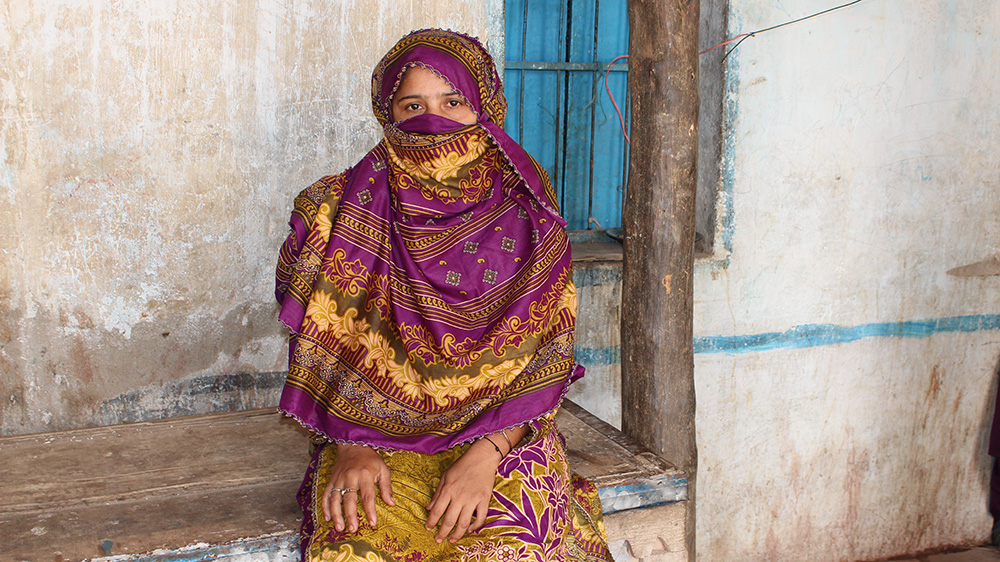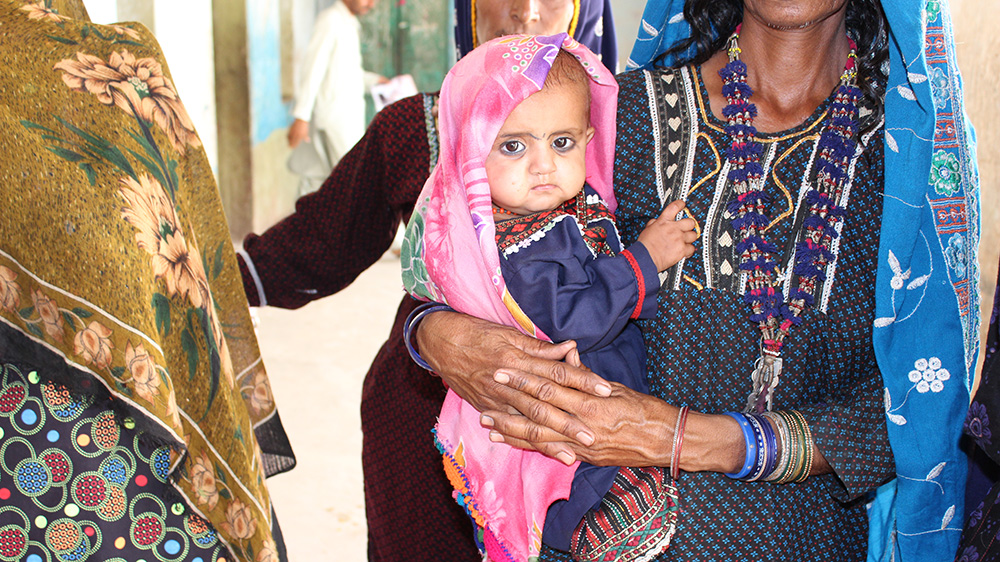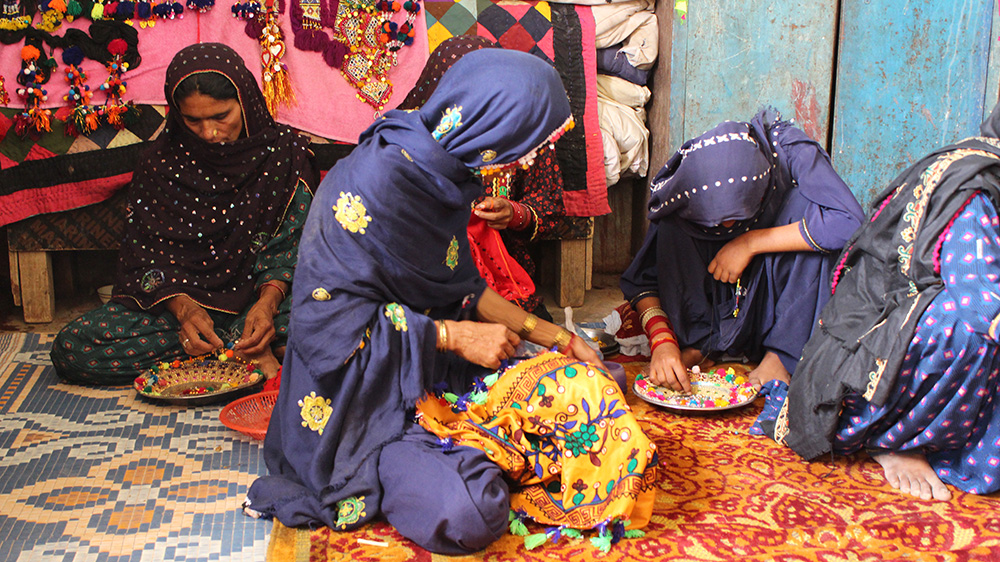A pregnant Amna faces endless hospital trips as heatwaves and power cuts grip her village. How is she coping, and what about other mothers facing the same struggles?
Just a few metres from where Rashida lives, a row of wind turbines lines the horizon, their blades turning in the hot, dry air. The turbines are part of a wind farm, one of many in the area, generating clean energy for private industries. For Rashida and her family, the farm offers nothing more than a curious backdrop to their everyday lives. Their house doesn’t get electricity, clean or otherwise.
In the desert-like outskirts of Jhimpir town, where the family lives, no electricity means there is little that can protect you against the summer heat that has become increasingly unbearable over the years. Even the winds that have always blessed Jhimpir’s lands and keep the wind farms running aren’t enough to cool you down anymore.
“At night, the wind was all you needed for a good sleep, even if you didn’t have electricity.”, Rashida says. “But even the wind is so hot now. It stings your skin and doesn’t make that much of a difference. You still feel hot, so hot that you end up falling sick.”

Jhimpir is located in Pakistan’s southern province of Sindh, where climate change has made heatwaves the new normal. Temperatures have risen above average in several cities since April, pushing the local government to issue heatwave alerts, advising people to stay indoors as much as possible and stay hydrated.
Although this year has been difficult, temperatures still haven’t reached the levels they did in 2024, when the mercury climbed as high as 52 degrees Celsius in two of Sindh’s cities, marking one of the highest temperature records in the province.
Extreme heat brings with it a sweep of consequences. In April, a hospital in Nawabshah city reported that at least 100 patients with heatstroke were arriving daily. Many suffered from high fever, gastroenteritis, diarrhoea, and vomiting and were hospitalised for serious treatment.
In 2024, there were over 5,000 hospital admissions for heat-related illnesses across Sindh. More than 500 people died within six days in June, with at least 20% of these deaths occurring on a single day, one of the hottest days in the province that year.
It’s easy to associate heatwaves with an illness like heatstroke, but few people realise how they affect pregnancy. The health of expecting mothers and their unborn babies is especially vulnerable to high temperatures.
Many pregnant women across Sindh are reporting feeling ill because of the heat. They complain of fainting in the heat and require hospitalisation due to dehydration. Many feel exhausted and lose their appetite, making it hard to manage pregnancy while carrying out tasks like caring for children, cleaning, tending livestock, farming, and cooking over a hot fire.
A study by the Aga Khan University Hospital, Sindh, on pregnant women has found that heat stress significantly affects pregnancy, resulting in low birth weight, stillbirths, or premature births. In a country already grappling with one of the world’s highest newborn death rates, the prospect of heatwaves causing more stillbirths and premature births, many of which can prove fatal, is deeply worrying.
Frequent power cuts in numerous cities, towns, and villages across Sindh mean there’s little hope of even a good night’s sleep under a fan or an air conditioner.
Skye Wheeler, a senior researcher at Human Rights Watch, emphasises how dangerous nighttime heat can be for health. “If you have a lot of heat during the day, but then at night, your body has a chance to recuperate and cool down, and you sleep, that makes things much better for your health than if you’re hot all day.
“If your body is struggling to stay cool even at night, and you have problems with your sleep, that can have a serious impact.”
Struggle to survive the heat
Rashida has witnessed the effects of high temperatures firsthand in her home. Her sister-in-law, Amna, is pregnant and bearing the brunt of the heat. “She’s not feeling well these days,” she says. “I can see how bad she’s feeling because of the heat. She’s 8months pregnant. On extremely hot days, she feels anxious, restless and agitated.
“She takes baths, twice or thrice a day, to keep cool, but that doesn’t help for long, and she starts feeling hot and uncomfortable again. She goes from one room to another, trying to find some cool spot to lie in. That doesn’t do anything either. Eventually, she starts feeling sick.”
The winds may have turned warm, but they still provide a small measure of relief to Amna on scorching days. After long, restless nights in the heat, the faint breeze finally helps her drift off to sleep during the day.

It isn’t just her sleep that’s been affected, though. Amna’s eating habits have taken a turn for the worse as well.
“She doesn’t feel like eating anymore,” Rashida says. “The heat makes her not want to eat anything. It kills her appetite. Makes digesting the food harder. If she does eat, she’ll vomit it up after a while. Even if she eats just one or two bites, she still vomits them up.”
While nausea and vomiting are common in early pregnancy, Amna’s problem isn’t morning sickness. It’s the heat. In the stifling temperatures, food feels heavy, digestion slows, and the body struggles to cope.
Rashida is a mother herself. She has three children, the eldest being nine and the youngest five. She’s braved the pangs of childbirth and postpartum recovery three times, but she admits her experience wasn’t as challenging as Amna’s currently.
“I’d wake up and go about my day as usual,” Rashida says. “I’d make breakfast, do the cleaning around the house, and rest. During the day, I’d do some sewing, stitching and embroidery work. I’d look after the children.
“Yes, it was hot back then, and I did struggle a bit. But it wasn’t this hot. The heat we’ve seen in the recent couple of years is something different.”
Rashida’s pregnancies also saw fewer emergency hospital visits, which is fortunate since hospital trips can be challenging for the family. The closest hospital is an hour away in Jhimpir. In more urgent cases, families must travel even further to the civil hospital in Hyderabad, which is approximately a 4-hour drive away by hired car.
“We’ve had to take Amna to the hospital at least two times recently. She was admitted to the emergency department. The doctor gave her medication through an IV and injections.
“They told us her condition was because of the heat. Every time we took her to the hospital, she’d get better when the doctors gave her medicine, they’d discharge us, and we’d return home. A few days after returning home, though, she’d start feeling anxious and restless again because of the heat.”
Rashida has seen women in her family and village giving birth prematurely. “You must put the baby in an incubator, then, at the hospital,” she says. “Whoever is meant to survive survives, but many don’t.”
There have been instances when someone pregnant in the house hasn’t been able to go to the hospital, and that’s when Rashida and Amna’s mother-in-law steps in. Rabia is the woman the family relies on for maternal health advice and wisdom.

“I didn’t learn professionally from anywhere,” she says. “I just watched and picked things up on my own. Whenever there’s someone who can’t go to the hospital or can’t afford the admission fee at the hospital to give birth there, I help them give birth at home.
Rabia knows the basics of what pregnant women should do to keep themselves cool during the heat. “I tell them to drink juice, water or dissolve some sugar into a glass of water and drink that,” she says. “The other women also take turns to keep them cool with a hand-held fan since there’s no electricity at home.”
No refuge from the heat
The relentless power cuts exacerbate the effect of the heat on women.
Sindh generates a significant share of Pakistan’s electricity from fossil fuels and renewable sources, making up about 26% of the total output. Overall, the country produces more than enough power to meet its demands. However, despite this surplus, issues such as poor transmission through the national grid and insufficient planning prevent the electricity from reliably reaching consumers.
Many Pakistanis depend on solar panels as an alternative to the national grid. Solar energy provides 25% of the country’s utility electricity, making Pakistan one of fewer than 20 countries worldwide that generate a quarter or more of their monthly electricity from solar energy.
However, while the panels themselves are relatively inexpensive to install, the batteries required for storing solar energy overnight are costly. “Many people report a very patchy electricity supply, and not everyone has a battery,” says Skye.
“Even if some families have a battery to store energy, allowing them to run a fan, they still can’t do this at night because the batteries often rely on solar power to operate, which they get as long as the sun’s out.”
Rashida’s family also installed a few solar panels on the roof of the house last year. “Electricity only comes to Jhimpir town, and not to our area,” she says. “We can only rely on solar panels to run the fans and TV, but they don’t work at night. We fan the kids with a hand fan at night when there’s no power so that they can sleep.”

Is the issue being addressed?
Heatwaves aren’t the only climate change disaster impacting Sindh. There have been catastrophic floods in the region over the years. The 2022 floods caused more than a thousand deaths and displaced at least 7.3 million people from their homes, about 13% of Sindh’s total population.
Sindh, much like the rest of the country, is facing a crisis it did not create. UN Secretary-General Antonio Guterres told the General Assembly in 2022 that Pakistan produces less than 1% of the world’s greenhouse gases. Yet, it is suffering heavily from climate change caused by others.
Floods often receive more attention than heatwaves when it comes to addressing their impact. Over the past three years, Sindh’s government has not mentioned any heatwave mitigation projects in its official development plans or budgets related to climate change, health, infrastructure development, or disaster recovery.
On the other hand, there are quite a few government schemes, some heavily funded, that address flooding.
The impact of heatwaves is often less visible than that of flooding, which may explain why it receives less attention. “It’s a different kind of disaster,” says Skye. “It doesn’t destroy buildings. It doesn’t destroy roads. It doesn’t have the same type of visible shock factor, and it doesn’t have the same kind of immediate impact on economies.”
Heatwaves may not have immediate, tangible implications, but in the long run, they do prove disastrous. “We do know that over time, heat has a huge impact on economies as well,” says Skye. Not only because people get sick and can’t work, or they can’t work as effectively, but also because it has a significant impact on nutrition, agriculture, and agricultural productivity. So, overall heat is a huge issue.”
Researchers and NGOs stress that the government must focus on tackling heatwaves, including their impact on pregnant women. A big part of the solution involves providing a continuous electricity supply to homes, whether through the transmission line or government-allocated solar panels and batteries, allowing women to use fans and stay cool.
If providing electricity to every home is challenging, then designated cooling spaces for women, such as maternal clinics, should have a reliable supply of electricity. “When they’re pregnant, women can just go and at least cool down for a little bit of time every day,” says Skye.
For Rashida, there is no going back to cool, windy days. She’s convinced heatwaves are here to stay. Her family is thinking about moving to a city where resources like electricity are less likely to be scarce than in their area, but it isn’t an easy decision. Their home sits on ancestral land, lived on and cared for by generations before them.
For the sake of the family’s women and the children, though, Rashida hopes they go through with the decision even if it comes at a heavy cost.
